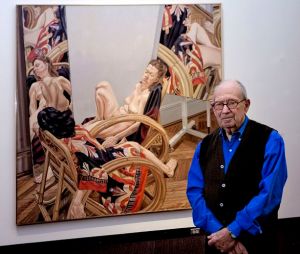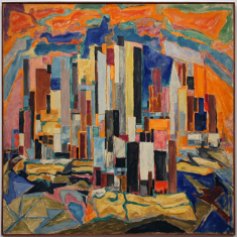
For a lover of contemporary realism, meeting with one of its main actor is very impressive and exciting! I was therefore beyond happy to be able to spend an afternoon with the legendary figure painter Philip Pearlstein during a lecture hold at the Art Council of Princeton in conjunction with the exhibition, Philip Pearlstein: A Legacy of Influence.
Philip Pearlstein is best known for his Modernist realist nudes and was among the American artists who led a revival in realist art, which started in the 60s. His work is present in major museums: the MET, the MOMA, the Whitney … to name a few. He has impacted the art scene through his work and as a teacher, theme of the exhibition curated by Charles Viera, former student and assistant of Pearlstein.
During this lecture, Pearlstein shared about his life and work and I was impressed by his sense of humor, wit and how at 92, his passion about art keeps him going. Here are a few extracts of this inspiring moment.
Charles Viera: You just finished a show G.I. Pearlstein WWII Captured on Paper at the Betty Cuningham Gallery (New York, NY)
Philip Pearlstein: yes. I was going through files with an assistant and saw works I had forgotten about. During WWII, I had kept a visual diary with sketches while I was in my unit. My father had kept them.
CV: Can you tell us about your life during WWII?
PP: I was 3 years in the army. We were trained on how to be a killer and how to survive. Being one of the smallest I was a favorite target during training so I learned how to defend myself. And that was a good training for the art world!
Then I was pulled out of the infantry and became a sign painter. After the war, I came back to the US and enrolled at Carnegie Institute in Pittsburgh where I met Andy Warhol with whom I moved to NYC after our studies to make our fortune. Andy was 5 years younger than me. Since his 2 older brothers knew my dad, they allowed him to move to NY with me. There he got some work immediately and it took a bit longer for me. I wanted to be an art director. I finally got a job as an assistant graphic designer and worked for 8 years on catalogues of plumbing and electrical machines.

CV: so you were painting alongside your job?
PP: I kept painting at night and got involved in a group of artists, known as The Club. In the 50s, the abstract expressionists got a lot of attention and the image of artists changed but the galleries were not interested. With the Club, I got involved in a coopt gallery: the Tanager Gallery (NB: among the founding members were also the artists Alex Katz and Tom Wesselmann). Every Friday night, the gallery was opened and hosted lectures with De Kooning among others. There were 200 people each time and it was all about ideas because nobody was selling anything! A lot of my generation became teachers and their ideas were based on the ideas of The Club.
 CV: Tell us about your artistic journey:
CV: Tell us about your artistic journey:
PP: After WWII, when I went back to college, I wanted to be a modernist because during WWII, Picasso had been discovered in Pittsburg! There was a big difference and everything was about modernism, Bauhaus ideas and Mondrian became my hero. Later on, in 1958, I got a scholarship to study in Italy and did “landscape masquerading as abstract”! I studied the figure drawing and all the major classic Italian painters. We also got to know many artists. From rocks, I started to paint Roman ruins as a symbol of destruction, and cliffs.
Upon my return to the US, I got hired as a teacher at Pratt Institute (Brooklyn). I had a class in design and one in figure drawing. At that time I didn’t care about the figure but I was interested in the composition. That’s how I went from rocks to bodies.
early works
CV: You de-romanticized the nude, treating it like one other still life project.
PP: I did my thesis on Francis Picabia and spent 3 years on it. He died in the middle of it but he had approved of it. I finally got published and suddenly became known as a writer. Then nobody would trust me as an artist! When I became a realist, some of my friends turned on me because I was the enemy! My goal was to get rid of the idea that the painting had any meaning. I was all about the composition.
 CV: what about the objects along your models?
CV: what about the objects along your models?
PP: I introduced the objects to make the painting more complicated. At first I used some Navajo rugs and did not realize they had a religious meaning. So I turned to manufactured rugs that had no meaning and stopped using anything that had any meaning. But it did not always work! Everything has a meaning.
While I was working on a picture of a male nude with two black marionettes (owned by the MOMA), a series of race riots erupted in Los Angeles. Some saw a meaning in the painting that was not there in the first place. I guess it’s out of the control of the artist…
CV: did you correct the people who got you wrong?PP: yes but they never listen!
CV: Did you have negative reaction to you art?
PP: yes. Once in Wichita, I had a show. People had to show their ID to enter and I was advised not to attend the show. Another time in a University in Tennessee (in 1962) a priest and a woman came and demanded that the show was taken down because I was “anti-American” and I was a threat to the morality of the teenagers. And the show was taken down.
I am surprised how the society is worried about not showing naked people but at the same time it’s everywhere. Somehow as soon as it’s a painting of a nude it has a different meaning!
landscape and cityscape, a less known part of his work










Amazing. Quite a discovery….Thanks!
LikeLiked by 1 person
[…] artists such as George Segal and Jim Dine, then the great masters of the return of painting, like Philip Pearlstein followed by Francesco Clemente and Julian Schnabel. Finally, we wanted to open up on current trends […]
LikeLike